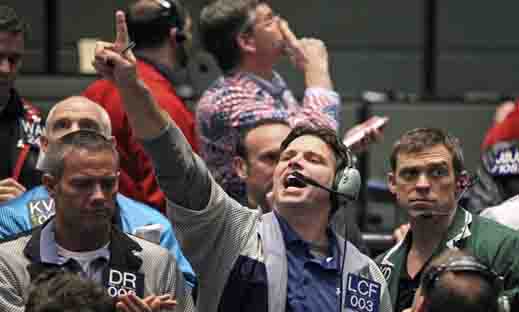S&P 500’s bear market may just be getting started
As the S&P 500 dipped into a bear market during intra-day trading last week, multiple analysts are warning worse is to come.
 Source: Bloomberg
Source: Bloomberg
After collapsing to 2,305 points on 20 March 2020, the S&P 500 soared to an intra-day record of 4,819 points on 4 January 2022.
But what the ultra-loose monetary conditions of the covid-19 pandemic era giveth, the increasingly hawkish Federal Reserve can taketh away. And while the index closed at 3,901 points on Friday, at times it dipped more than 20% from its January high.
S&P 500 bear market
It could have much, much further to fall. Jeremy Grantham believes ‘at a minimum, we are likely to do twice that. If we're unlucky — which is quite possible — we would do three legs like that.’
Meanwhile, Guggenheim CIO Scott Minerd argues the US is in for a ‘summer of pain,’ while Big Short investor Michael Burry thinks the crash is likely to intensify.
As BTIG analyst Jonathan Krinsky notes ‘the issue now is there really appears to be nowhere to hide.’ While early-stage growth stocks like Peloton, Roblox and Zoom have all seen share price collapses, titans like Amazon, Alphabet, Meta, and Apple are also suffering.
But while tech sector falls are to be expected, retail stalwarts Target, Walmart, and Ross Stores were all hit last week by the escalating cost-of-living crisis. Walmart President and CEO Doug McMillon warns that ‘not all of them can afford to absorb this…the rate of inflation in food pulled more dollars away from general merchandise than we expected as customers needed to pay for the inflation in food.’
Oanda analyst Edward Moya believes ‘results from Walmart and Target this week have brought into sharp focus the plight facing companies and consumers as inflation begins to bite,’ and notes a ‘feeling of inevitability’ about a near-term economic slowdown.
Meanwhile, S&P Global Ratings expert Sarah Wyeth thinks ‘it really surprised the market because everyone knows the consumer has been strong with cash savings and a tight labor market… but this shift is earlier than expected. We’ve now reached an inflection point.’
With nominal retail sales rising by 0.9% in April, Capital Economics analyst Paul Ashworth believes that ‘despite the surge in prices weighing on their purchasing power, the U.S. consumer now appears to be single-handedly keeping the global economy afloat.’
 Source: Bloomberg
Source: Bloomberg
2022 recession risks
Multiple recessionary factors are hitting the US economy. The supply chain crunch, which began as the global economy reopened, has worsened under Russia’s war in Ukraine. Commodities from oil to gas, to wheat, fertiliser, and crucial metals, are at sky-high prices with shortages expected to worsen.
Meanwhile, pandemic resurgence in China saw industrial output fall 2.9% and retail sales by 11.1% in April. Shanghai, the busiest port in the world, was forced into complete lockdown. Goldman Sachs says ‘the situation in China remains highly uncertain, and more prolonged disruptions would pose upside risk to U.S. inflation in the second and third quarters and downside risk to U.S. growth.’
Ex-CEO Lloyd Blankfein believes there is a ‘very, very high risk’ of a recession, while chief US equity strategist David Kostin has put the chances of a downturn in the next two years at 35%, predicting the S&P 500 could fall another 11 to 18% based on historical data.
And as the US economy already contracted last quarter, Truist co-chief investment officer Keith Lerner believes ‘recession risks have taken center stage on the carousel of concerns.’
Although CPI inflation dipped to 8.3% in April, it’s still at a four-decade high. Accordingly, the Federal Reserve increased interest rates by 50 basis points at its last meeting, and Chair Jerome Powell ‘won’t hesitate at all’ to ratchet rates up past 2-3%.
Moody’s chief economist Mark Zandi thinks the Reserve has ‘raised recession fears’ and puts the odds of recession at 33% in the next 12 months, and nearly 50% in the next 24.
The impact on the S&P 500 is not looking good. The Bank of America thinks that entrenched stagflation could create a ‘worst case’ scenario where the index falls to 3,200 points. Strategist Savita Subramanian warns ‘recession risks are taking over,’ with market psychology now alike to the dot-com bubble with its ‘acceptance of the unthinkable.’
Deutsche Bank US equity and global strategist, Binky Chadha, believes it could fall to as little as 3,000 points. Despite believing a relief rally could spear it to 4,750, the analyst accepts the risk of a ‘protracted selloff’ could create a ‘self-fulfilling recession.’ He notes ‘inflation is proving sticky and the Fed’s forward guidance is for a rate hiking cycle that has historically ended in recession more often than not.’
And Nationwide’s Mark Hackett highlighted that after 1920, 1980, and 2001, 2022 marks the fourth time the S&P 500 has posted a loss for seven weeks in a row. The analyst observed that ‘unfortunately, the index was negative over the next 12-months each time.’
Of course, most analysts thought the S&P 500 would take years to recover from the March 2020 pandemic-induced crash.
But a sustained bear market now appears more likely than not.
Trade what you want, when you want with the UK’s No.1 trading provider.* We have over 80 top global indices with more trading hours than anyone else. Find out more about indices trading or open an account to trade now.
*Based on revenue excluding FX (published financial statements, June 2020).





.jpg.27c55ea07d5a17683fbdbda06b8fcace.jpg)
0 Comments
Recommended Comments
There are no comments to display.
Create an account or sign in to comment
You need to be a member in order to leave a comment
Create an account
Sign up for a new account in our community. It's easy!
Register a new accountSign in
Already have an account? Sign in here.
Sign In Now